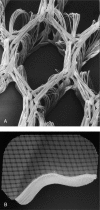A multicentric comparison of transabdominal versus totally extraperitoneal laparoscopic hernia repair using PARIETEX meshes
- PMID: 10917122
- PMCID: PMC3015374
A multicentric comparison of transabdominal versus totally extraperitoneal laparoscopic hernia repair using PARIETEX meshes
Abstract
The authors report a series of 1972 inguinal hernias treated between 1993 and 1997 by the insertion of a PARIETEX mesh via either a transabdominal-preperitoneal (TAPP) (1,290 procedures) or a totally extraperitoneal TEP approach (682 procedures). Pain scores were equivalent in both groups, while the hospital stay and time to return to normal activity was lower in the TEP group than in the TAPP group (p<0.001). In both groups, the average incidence of the total reported events (complications) was around 10% with no statistical difference. This ratio seemed to compare favorably to previously published reports. Chronic pain was extremely rare (0.6% and 0.7% in the TAPP and TEP groups, respectively). Whatever the approach was, sepsis was also very rare (1/1,526 laparoscopic procedures). These findings illustrate the local tolerance of the mesh. Recurrence rates were below 1% with no statistical difference between groups. This retrospective study demonstrates the clinically apparent local tolerance of this type of mesh. Prospective and long-term clinical results will be necessary to demonstrate that the optimized short-term tolerance of PARIETEX mesh will influence the long term functional results.
Figures

References
-
- Glassow F. Inguinal hernia repair. A comparison of the Shouldice and Cooper ligament repair of the posterior inguinal wall. Am J Surg. 1976;131:306–311 - PubMed
-
- Liem MSL, van Steensel CJ, Boelhouwer RU, et al. The learning curve for totally extraperitoneal laparoscopic inguinal hernia repair. Am J Surg. 1996;171:281–285 - PubMed
-
- Amid PK, Shulman AG, Lichtenstein IL. Critical scrutiny of the open “tension-free” hernioplasty. Am Surg. 1993;165:369–371 - PubMed
-
- Stoppa RE, et al. The use of Dacron in the repair of hernias of the groin. Surg Clin North Am. 1984;64:269–286 - PubMed
Publication types
MeSH terms
Substances
LinkOut - more resources
Full Text Sources
